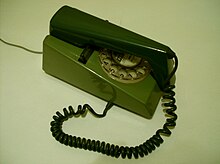On- and off-hook
In telephony, on-hook and off-hook are two states of a communication circuit. On subscriber telephones the states are produced by placing the handset onto or off the hookswitch. Placing the circuit into the off-hook state is also called seizing the line. Off-hook originally referred to the condition that prevailed when telephones had a separate earpiece (receiver), which hung from its switchhook until the user initiated a telephone call by removing it. When off hook the weight of the receiver no longer depresses the spring-loaded switchhook, thereby connecting the instrument to the telephone line.
Off-hook

The term off-hook has the following meanings:
- The condition that exists when a telephone or other user instrument is in use, i.e., during dialing or communicating.
- A general description of one of two possible signaling states at an interface between telecommunications systems,[1] such as tone or no tone and ground connection versus battery connection. Note that if off-hook pertains to one state, on-hook pertains to the other.
- The active state (i.e., a closed loop (short circuit between the wires) of a subscriber line or PBX user loop)
- An operating state of a communications link in which data transmission is enabled either for (a) voice or data communications or (b) network signaling.[2][3]
On an ordinary two-wire telephone line, off-hook status is communicated to the telephone exchange by a resistance short across the pair. When an off-hook condition persists without dialing, for example because the handset has fallen off or the cable has been flooded, it is treated as a permanent loop or permanent signal.
The act of going off-hook is also referred to as seizing the line or channel.
On-hook

The term on-hook has the following meanings:
- The condition that exists when a telephone or other user instrument is not in use, i.e., when idle waiting for a call. Note: on-hook originally referred to the storage of an idle telephone receiver, i.e., separate earpiece, on a switchhook. The weight of the receiver depresses the spring-loaded switchhook thereby disconnecting the idle instrument (except its bell) from the telephone line.
- One of two possible signaling states, such as tone or no tone, or ground connection versus battery connection. Note: if on-hook pertains to one state, off-hook pertains to the other.
- The idle state, i.e., an open loop of a subscriber line or PBX user loop.
- An operating state of a telecommunication circuit in which transmission is disabled and a high impedance, or "open circuit", is presented to the link by the end instrument(s). Note: during the on-hook condition, the link is responsive to ringing signals.
The act of going on-hook is also referred to as releasing the line or channel, and may initiate the process of clearing.
See also
References
![]() This article incorporates public domain material from Federal Standard 1037C. General Services Administration. Archived from the original on 2022-01-22. (in support of MIL-STD-188).
This article incorporates public domain material from Federal Standard 1037C. General Services Administration. Archived from the original on 2022-01-22. (in support of MIL-STD-188).
- ^ Rey, R. F. (1984). "Engineering and Operations in the Bell System, 2nd Ed". Bell Telephone Laboratories. p. 267. Retrieved 19 March 2017.
- ^ Federal Standard 1037C
- ^ MIL-STD-188
